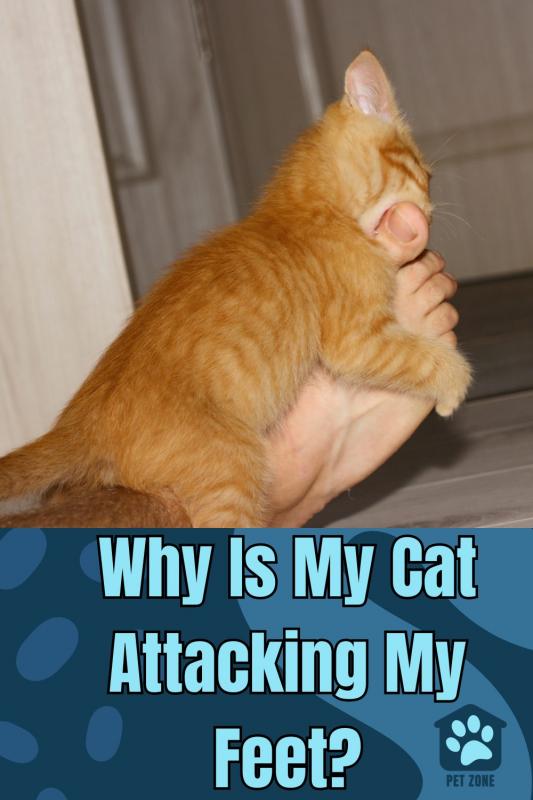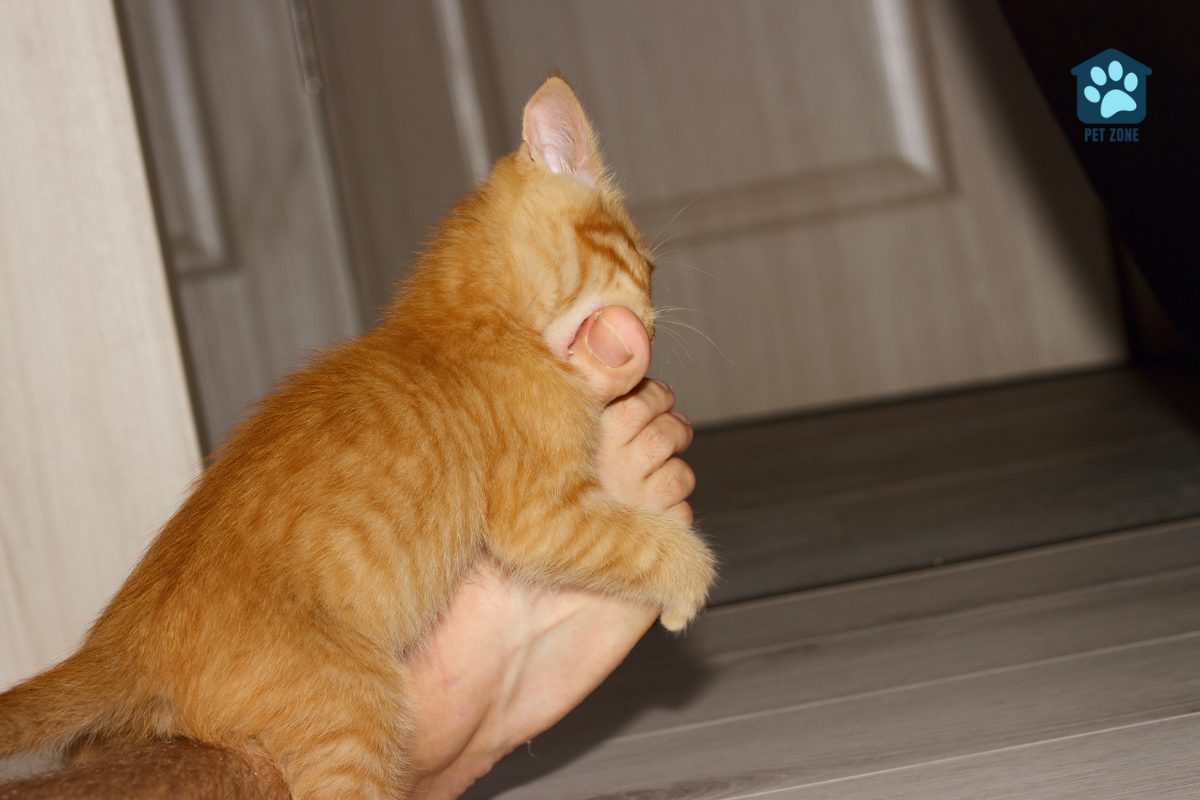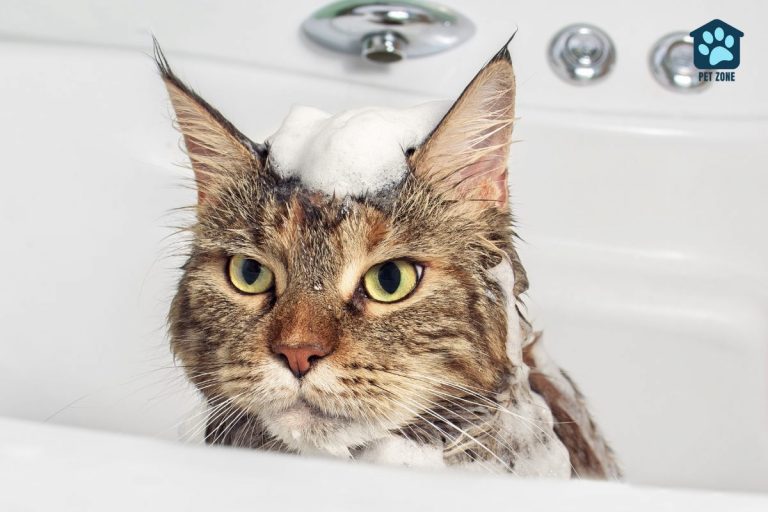Estimated reading time: 10 minutes
Are you tiptoeing around your home, only to become the target of your feline’s lightning-fast paws? If your normally cuddly cat has turned into a foot hunter, leaving you with scratches and playful bites on your ankles, know that you’re not alone.
Many cat owners experience this quirky yet common behavior and often wonder what drives their kittens to suddenly ambush their feet.
Your cat’s behaviors are influenced by instincts, emotions, and their environment. Cats possess natural predatory instincts which can manifest in their play–leading them to see moving feet as potential prey or toys.
This article aims to unravel the mystery behind this feisty foot frenzy; from deciphering body language clues to addressing underlying issues for peace between your toes and kitty’s claws.
Key Takeaways
- Cats may attack feet as part of playful behavior, their natural hunting instincts, or because they want attention.
- To stop your cat from attacking your feet, give them lots of toys and play with them often to use up their energy.
- Understand your cat’s body signals like tail movements and ear positions to know how they feel.
- If stress, medical issues, or being very protective of their space cause foot attacks, you might need a vet or animal expert’s help.
- Keep cats happy by making a quiet place for them at home and keeping a regular routine.
Reasons Why Cats Attack Your Feet
Playful behavior
Cats often attack feet because they’re in a playful mood. Your moving toes can seem like a fun toy to them. Kittens especially have lots of energy and will pounce on anything that moves, including your feet.
Playtime is important for cats as it helps them use up their excess energy. Give your cat plenty of toys to chase and bite instead of letting them play with your hands or feet. This teaches them what’s okay to attack and what’s not.
Engage in regular play sessions using toys that mimic the movements of small prey animals. This way, you redirect their need to hunt toward appropriate targets and away from your feet.
Hunting instincts
Cats have a natural drive to hunt that can explain why they sometimes attack your feet. Your moving toes might remind them of small prey scurrying around. This instinct is strong in indoor cats, especially if they don’t get enough playtime to act on their hunting urges.
It’s not just for food; it’s also a way for them to practice these important skills and keep their senses sharp.
To manage this behavior, make time to play with your cat using toys that mimic the thrill of the chase. Dangling feathers or mice toys can distract them from biting your toes and redirect their focus toward something more appropriate.
Engaging in regular play sessions helps satisfy their urge to pounce without hurting you. It’s better for you both—you get scratch-free feet, and your cat stays happy and healthy!
Attention-seeking
Your cat may bite your feet simply because they want to get your attention. If they feel like you’re not giving them enough love or playtime, attacking your feet gets a reaction.
They learn that biting or pouncing at your feet makes you look down and focus on them, even if it’s just to say “stop.” Your furry friend might be craving interaction and this is their way of asking for it.
To make sure your cat gets the right kind of attention, schedule regular play sessions. This helps prevent unwanted foot attacks by keeping your pet happy and engaged.
Preventing Your Cat From Attacking Your Feet
Providing appropriate toys and playtime
Give your cat a variety of toys to keep them entertained. Toys like balls, feathers, and interactive puzzles can simulate hunting behaviors and keep their attention away from your feet.
Spend time playing with your cat every day to fulfill their need for exercise and mental stimulation, which can reduce foot-attacking behavior. Set regular play sessions to ensure they have enough activity throughout the day.
Reinforce positive behavior by rewarding them with treats or praise when they use toys appropriately instead of attacking your feet. Rotate their toys regularly to maintain their interest and prevent boredom.
Redirecting attention
To deter your cat from attacking your feet, redirect their attention to appropriate toys and activities. When you notice them gearing up for an attack, toss a toy or engage them in interactive play to shift their focus away from your feet.
Providing enticing scratching posts and puzzle feeders can also keep their mind occupied and prevent foot-attacking behavior. By redirecting their energy towards these alternatives, you can help satisfy their natural instincts while safeguarding your toes from unwanted nibbles.
Creating a calm environment is also essential for redirecting your cat’s attention away from foot-attacking behavior. Ensuring they have a peaceful space with comfortable bedding and soothing background sounds can reduce stress and promote positive behaviors.
Creating a calm environment
After redirecting your cat’s attention and providing appropriate toys, creating a calm environment is vital. Cats thrive in peaceful surroundings, so ensure their living space is tranquil.
Reduce loud noises and sudden movements to help them relax and feel secure. Providing cozy hiding spots can also give your cat a sense of safety when they need some alone time. Additionally, maintaining a consistent routine for feeding and playtime can contribute to a serene atmosphere at home.
Remember to dedicate quiet spaces where your cat can retreat if feeling overwhelmed by household activities or visitors. This helps them manage stress better and decreases the likelihood of attacking feet due to anxiety or discomfort in their environment.
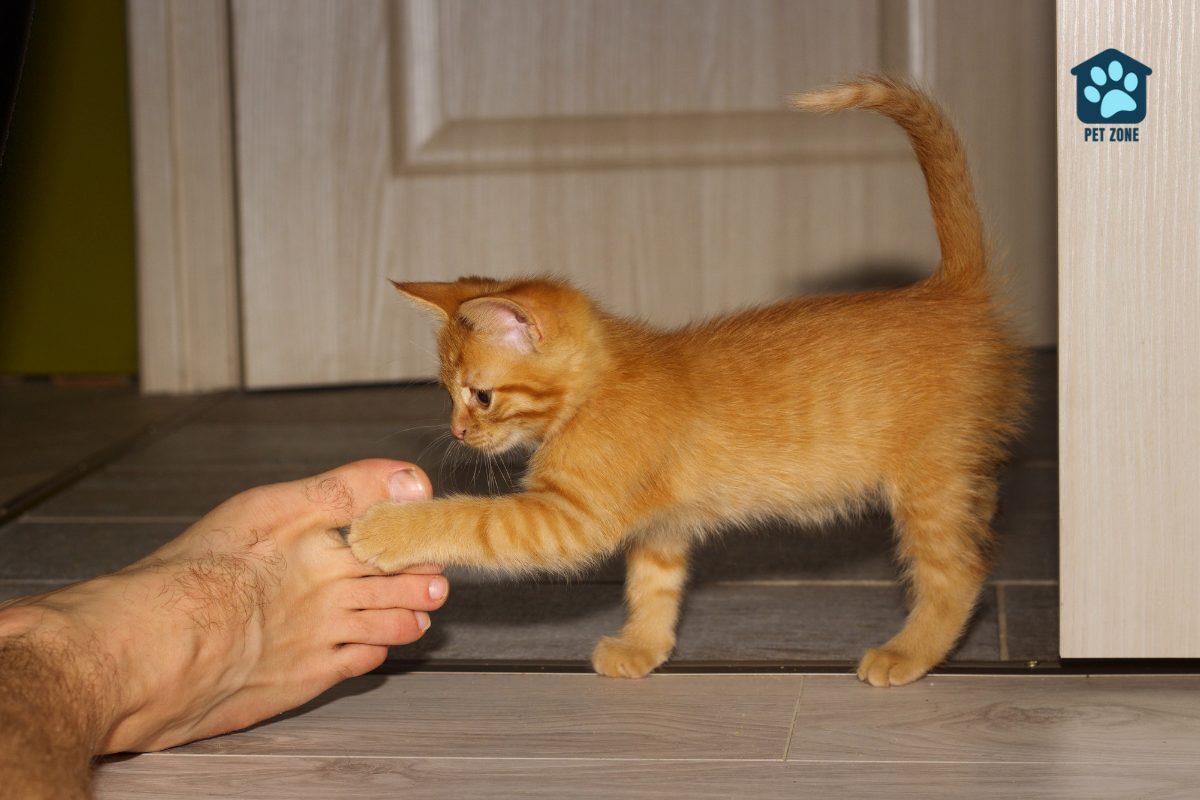
Understanding Your Cat’s Body Language and Signals
Observe your cat’s tail movements, ear positioning, vocalizations, and pupil dilation to gain insight into their feelings and intentions. Understanding these signals can help you better communicate with your feline friend.
If you want to learn more about decoding your cat’s body language, keep reading!
Reading tail movements
When observing your cat’s tail movements, you can gain insight into their mood. A relaxed and upright tail indicates a content and friendly demeanor, while a puffed-up or lashing tail signals agitation or aggression.
If the tail is twitching quickly, it may mean excitement or irritation. Understanding these movements helps in responding appropriately to your cat’s emotional state.
By paying attention to your cat’s tail language along with other body signals like ear positioning and vocalizations, you can effectively interpret their feelings and respond accordingly.
Noticing ear positioning
Just as tail movements can give insight into your cat’s feelings, paying attention to their ear positioning is crucial. When a cat’s ears are forward, it typically signifies that they are feeling curious or friendly.
On the other hand, flattened ears indicate aggression or fear. If you notice your cat’s ears are moving back and forth rapidly, it could be a sign of irritation or anxiety. By observing their ear positioning, you can better understand your cat’s emotions and respond accordingly to ensure a harmonious environment for both of you.
Understanding these subtle cues will help you communicate effectively with your feline friend and address any underlying issues that may be causing foot-attacking behavior.
Paying attention to vocalizations
When your cat vocalizes, pay attention to the types of sounds it makes. Cats can meow, yowl, growl, or purr. Each sound conveys different emotions and needs. For example, a high-pitched meow might indicate excitement or a request for attention, while a deep growl could signal aggression or discomfort.
By understanding your cat’s vocalizations, you can better respond to its needs and emotions. It can help you recognize when your cat is happy, anxious, in pain, or seeking interaction with you.
Paying attention to these vocal cues will deepen your bond with your feline friend and help address any underlying issues affecting its behavior.
Recognizing pupil dilation
When paying attention to your cat’s body language, recognizing pupil dilation can provide valuable insights into their emotions. Cats’ pupils dilate in response to various stimuli, such as excitement, fear, or aggression.
Dilated pupils indicate arousal or heightened emotional state, while constricted pupils may suggest discomfort or stress. By observing changes in your cat’s pupil size, you can better understand their mood and respond accordingly to ensure their well-being.
Understanding the significance of pupil dilation in cats allows you to interpret their feelings more accurately. It serves as a crucial indicator of their emotional state and helps you gauge how they are responding to different situations.
Identifying Underlying Issues and Seeking Help
Identifying the underlying reasons for your cat’s foot-attacking behavior is crucial in addressing the issue effectively. Whether it’s stress, medical issues, or territorial behavior, understanding the root cause will help you seek appropriate help and find a solution for your feline companion.
Stress or anxiety
Cats can become stressed or anxious, which may lead to them attacking your feet. Changes in their environment, such as moving to a new home or the introduction of new pets, can cause stress.
Loud noises and unfamiliar visitors can also make them anxious. To help alleviate stress or anxiety in your cat, create a safe and quiet space for them to retreat to when they feel overwhelmed.
Providing stimulating activities and interactive toys can also help reduce their anxiety levels.
Medical reasons
It’s important to consider medical reasons when your cat is attacking your feet. Sometimes, cats may exhibit aggressive behavior due to pain or discomfort caused by an underlying health issue.
For instance, if your cat is experiencing dental problems, arthritis, or any other painful condition, they may act out by attacking feet as a way of expressing their discomfort.
Therefore, it’s crucial to observe any changes in your cat’s behavior and consult with a veterinarian if you suspect that there might be an underlying medical reason for their foot-attacking behavior.
Understanding and addressing potential medical issues can significantly improve your cat’s overall well-being and help mitigate the foot-attacking behavior. Additionally, regular veterinary check-ups can aid in identifying and managing any health concerns that could be contributing to this type of aggression.
Territorial behavior
Territorial behavior is common in cats. They may attack your feet to protect their territory. Cats can feel threatened if they think someone is invading their space. This behavior might be more noticeable if you have multiple cats.
It’s vital to give each cat its own space and resources to reduce territorial conflicts.
If your cat shows signs of aggression towards you, consider seeking help from a professional animal behaviorist or veterinarian. They can provide guidance on managing territorial issues and creating a harmonious environment for your feline friends.
Seeking professional help if necessary
If you’ve tried different strategies and your cat’s foot-attacking behavior persists, it might be time to consult a veterinarian or a certified animal behaviorist. This is especially important if the behavior appears aggressive, excessive, or linked to potential medical issues.
A professional can help identify any underlying health concerns or provide specialized guidance for modifying your cat’s behavior effectively. Remember, seeking expert assistance can offer valuable insights and personalized solutions tailored to your cat’s specific needs.
Understanding these common reasons for foot-attacking behaviors can empower you to address this issue constructively and strengthen the bond with your feline friend. With this knowledge, let’s explore how to create a nurturing environment that promotes positive interactions and enriches your cat’s well-being.
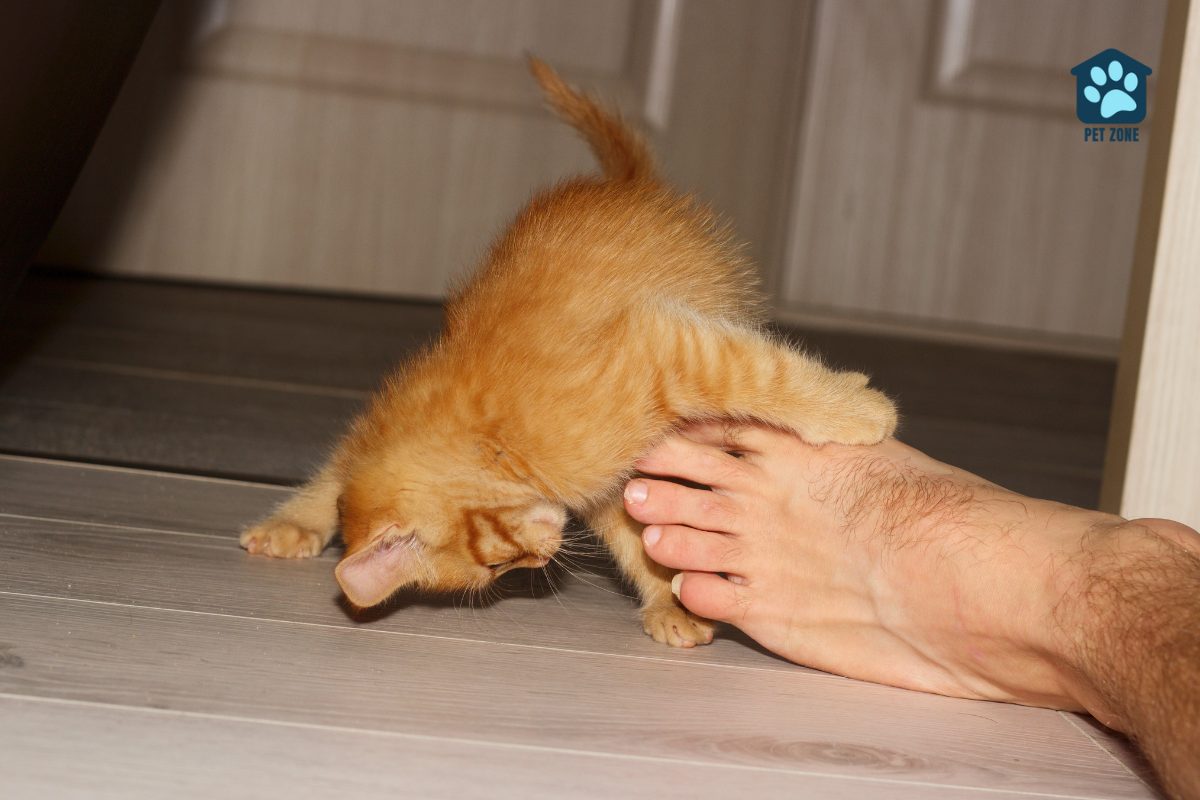
Conclusion
Understanding why your cat is attacking your feet can help you address this behavior effectively. By recognizing the reasons behind their actions, such as playful behavior or hunting instincts, you can take practical steps to prevent and manage it.
The strategies provided are easy to implement and can have a significant impact on improving your relationship with your feline friend. Consider observing your cat’s body language and seeking professional help if needed to ensure their well-being.
Remember, creating a calm environment and providing appropriate toys for playtime can make a positive difference in curbing this behavior.
As an Amazon Associate I earn from qualifying purchases.
